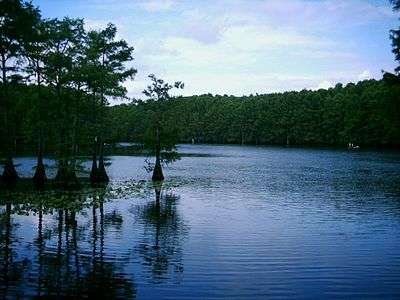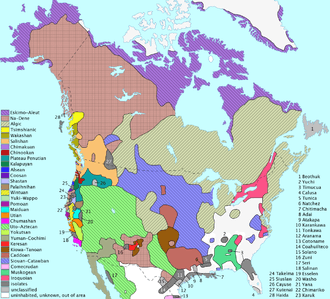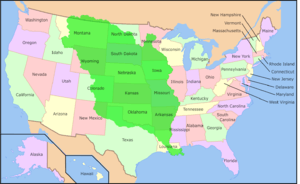Caddo Lake State Park
| Caddo Lake State Park | |
| Texas State Park | |
 Caddo Lake viewed from a point near Uncertain | |
| Name origin: Named for the Caddo Indians, who inhabited the area | |
| Country | United States |
|---|---|
| State | Texas |
| Region | East Texas |
| District | Harrison County |
| Municipality | Karnack |
| Location | Karnack [1]
|
| - elevation | 237 ft (72 m) |
| - coordinates | 32°41′27″N 094°10′45″W / 32.69083°N 94.17917°WCoordinates: 32°41′27″N 094°10′45″W / 32.69083°N 94.17917°W |
| Area | 468 acres (189 ha) [2] |
| Biome | Wetlands, freshwater |
| Founded | June 1933 |
| Management | Texas Parks and Wildlife Department |
| IUCN category | IV - Habitat/Species government Area |
|
Location of Caddo Lake State Park in Texas
| |
| Website: Caddo Lake State Park | |
Caddo Lake State Park is a state park located in eastern Texas. Caddo Lake, the lake that the state park encompasses, is one of only a handful of natural lakes in Texas. The park consists of 8,253 acres (3,340 ha) west of the lake itself, in Harrison County, near Karnack, Texas. The lake and surrounding area was drilled for petroleum in the 1900s. The lake was created by a gigantic log jam known as the Great Raft.
History
Early inhabitants and exploration

The first humans settled in the area near the park around 10,000 BC. For several centuries, these people used the marshlands of Caddo Lake to gather food.[3] Sometime around 800 AD, the first Caddo settlements appeared in the area. At the time, the tribes in the region were not a connected nation, instead being a large collection of close-knit, peaceful gathering communities. Over time, the Caddo communities grew and prospered, becoming a highly farming community by at least 1200 AD, learning to grow crops such as maize (corn).[4]
In 1542, the Francisco de Soto expedition, led by Luis de Moscoso Alvarado due to De Soto's death earlier in the expedition, discovered the complex Caddoan society. They sent back the first descriptions of the Caddo. Several more European expeditions explored the area around the park throughout the 1600s.[4][5] The Spanish established several Missions and trading-posts during the 1700s, and numerous epidemics caused by the European settlements virtually wiped out the Caddo that inhabited the area. They used the nearby Red River for trading.[6]
1800s

1800–1812
In 1800, as part of the secret Treaty of San Ildefonso, Spain, who had been defeated in the Napoleonic Wars, was forced to return Louisiana to France. France regained Louisiana in 1802, two years later.[7] This treaty did not establish the borders of Louisiana, which would lead to issues just a short while later.[8] In early 1803, diplomat James Monroe was sent to France to negotiate purchasing Louisiana from France. Louisiana was bought from France later that year. This was known as the Louisiana Purchase, which doubled the size of the United States. The northeastern part of Texas was thought to be included in the purchase.[9] There was no official border between Louisiana and Texas, which caused disputes between Spain and the United States. In 1806, United States General James Wilkinson and Spanish Lieutenant Colonel Simón de Herrera attempted to negotiate establishing a border between the two nations. On November 5, 1806, an agreement was made to establish a Neutral territory between the two countries. The neutral territory did not have official borders, and the Caddo Lake area was likely located within the territory.[10] Because the territory was not possessed by either nation, neither of them could enforce laws in the territory, so it became popular with outlaws and escaped slaves. In both 1810 and 1812, the two nations sent joint military expeditions into the Neutral Territory to expel the outlaws inhabiting it.[11]
Formation of Caddo Lake

Although the exact date of the formation of Caddo Lake is unknown, both of the major theories behind the lake's origins date back to the early 1800s. The Caddo legend behind the formation of the lake is that the Great Spirit caused an earthquake after one of the Caddo chiefs failed to obey him. The earthquake filled and formed the lake.[12] The earthquake being described in the story is the 1812 New Madrid earthquake, which is believed by some geologists to have caused the creation of the lake. The theory behind the earthquake creating Caddo Lake is that the earthquake's seismic waves caused the ground to sink, which filled up and became the lake.[13] The additional theory behind the creation of Caddo Lake was that it formed because of the Great Raft. The Great Raft was a large log jam that blocked the flow of the Red River, as well as a few smaller rivers. The jam was first reported by early Spanish explorers in the 1500s, but was not studied until the early 1800s. It is believed that Caddo Lake was formed by the Great Raft acting as a natural dam, and the first studies of this were reported around 1806.[14][15]
1819–1829
In 1819, the Adams-Onis Treaty was signed, which established the border between Spanish Texas and Louisiana. The border between the two was set along the Sabine River and the 32nd parallel, which placed the Caddo Lake Area within the borders of Texas.[16] In 1821, after 11 years of fighting, the Spanish territory of Mexico won its independence. This included the area of the present-day Caddo Lake state park.[17] Winning the Texas Revolution allowed the Republic of Texas to become independent from Mexico and be annexed by the United States.
1900s
1931–1937
The 1931 Texas Legislature dedicated state property at Caddo Lake as a public park. Institutions and individuals also donated land. Civilian Conservation Corps (CCC) Company 889 began development of the park in 1933. They began building entrance portals, Texas Park Road 2, trails, a shelter house, a boat house, nine cabins, a concession building (currently the group recreation hall), picnic sites, culverts, vehicle bridges, and a well house. CCC Company 857 finished the work in 1937.[18]
Natural Features
Caddo Lake State Park is named for Caddo Lake, a sprawling maze of bayous and sloughs covering 26,810 acres (10,850 ha) of cypress swamp. The average depth of the lake is 8–10 ft (2.4–3.0 m), with the deep water in the bayou averaging about 20 ft (6.1 m). An angler's delight, the lake contains 71 species of fish. It is especially good for crappie, largemouth bass, and white bass. Naturalists can enjoy stately cypress trees, American lotus, water lilies, waterfowl, alligators, turtles, frogs, snakes, raccoons, mink, coypu, beavers, squirrels, armadillos, and white-tailed deer.
Nearby state parks
The following state park is located within 30 miles (48 km) of Caddo Lake State Park:[19][20][21]
- Starr Family Home State Historic Site (Harrison County)
Image gallery
 Channel in Caddo Lake
Channel in Caddo Lake Caddo Lake during winter.
Caddo Lake during winter.
See also
| Wikimedia Commons has media related to Caddo Lake State Park. |
References
- Footnotes
- ↑ Geographic Names Information System, United States Geological Survey (November 30, 1979). "Geographic Names Information System Feature Detail Report: Caddo Lake State Park". Retrieved September 12, 2012.
- ↑ Texas State Parks p. 114
- ↑ Staff. "History". Caddo Lake State Park. Texas Department of Parks and Wildlife. Retrieved September 18, 2012.
- 1 2 Timothy K. Perttula. "Caddo Indians". Handbook of Texas Online. Texas State Historical Association. Retrieved September 17, 2012.
- ↑ Randolph B. Campbell. "Harrison County". Handbook of Texas Online. Texas State Historical Association. Retrieved September 17, 2012.
- ↑ Smith, F. Todd (2000). The Caddo Indians: Tribes at the Convergence of Empires, 1542-1854. College Station: Texas A&M University Press. ISBN 978-0-89096-981-6.
- ↑ Crossroads of North America pp. 124–125
- ↑ Schoultz 1998 pp. 15–16
- ↑ "The Louisiana Purchase". A Heritage Explored. Louisiana State University. Retrieved September 24, 2012.
- ↑ Haggard, J. Villasana (October 1945). "The Neutral Ground Between Louisiana and Texas, 1806-1821". Louisiana Historical Quarterly. Louisiana Historical Association. 28: 4.
- ↑ John V. Haggard. "Neutral Ground". Handbook of Texas Online. Texas State Historical Association. Retrieved September 25, 2012.
- ↑ Seth D. Breeding and Sallie Starr Lentz. "Caddo Lake". Handbook of Texas Online. Texas State Historical Association. Retrieved September 26, 2012.
- ↑ Texas State Parks p. 112
- ↑ Red River Steamboats p. 7 "Spanish explorers reached the Red River in the 16th century, and discovered a massive jam of fallen trees and debris. This natural damming came to be known as "The Great Raft."[...] Although the French and Spanish explored the region during the 18th century, a thorough effort to explore and document the river did not occur until it came into the hands of the United States in 1803. The first thorough exploration occurred in 1806 with the Freeman Custis Expedition, which ascended the Red, but was eventually stopped by Spanish military forces"
- ↑ Drago, Harry Sinclair (1962). Red River Valley: The mainstream of frontier history from the Louisiana Bayous to the Texas Panhandle. New York: Clarkson-Potter. OCLC 545274.
- ↑ Bemis, Samuel Flagg (1981). John Quincy Adams and the Foundations of American Foreign Policy. Westport, CT: Greenwood Press. ISBN 0-313-22636-9.
- ↑ "Mexican Independence from Spain". The Border–History. PBS. Retrieved October 4, 2012.
- ↑ The Look of Nature: Designing Texas State Parks During the Great Depression. Texas Parks and Wildlife Department. Retrieved August 9, 2014.
- ↑ Staff. "Overview". Caddo Lake State Park. Texas Department of Parks and Wildlife. Retrieved September 18, 2012.
- ↑ Staff. "Map & Directions". Starr Family Home State Historic Site. Texas Historical Commission. Retrieved September 18, 2012.
- ↑ Michels, Chris (1997). "Latitude/Longitude Distance Calculation". Northern Arizona University. Retrieved September 18, 2012.
- Bibliography
- De La Teja, Jesús F.; Paula Marks; Ron Tyler (2004). Texas: Crossroads of North America, A History. Boston, MA: Houghton Mifflin Company. ISBN 0-618-96966-7.
- Joiner, Gary; Brock, Eric (1999). Red River Steamboats–Images of America. Charleston, SC: Arcadia Publishing. ISBN 978-0-7385-0168-0.
- Parent, Laurence (2008). Official Guide to Texas State Parks and Historic Sites (2nd ed.). Austin: University of Texas Press. ISBN 978-0-292-71726-8.
- Schoultz, Lars (1998). Beneath the United States. Cambridge, MA: Harvard University Press. ISBN 978-0-674-92276-1.